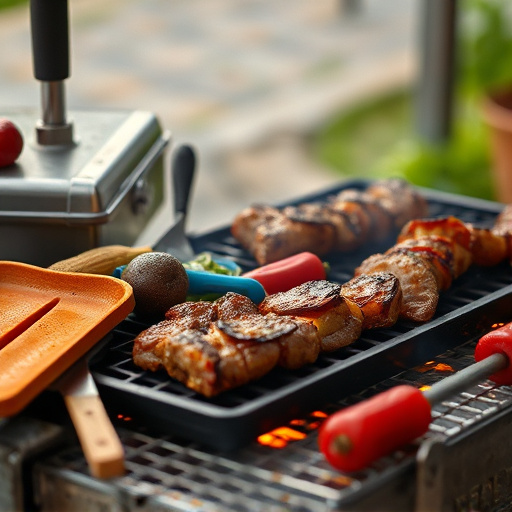Choosing the right cut of BBQ pork ribs (like baby back or St. Louis-style) is key for success. Remove membranes, score meat, and follow a proven preparation method. Opt for high-quality, fresh ribs with good marbling to ensure juiciness. Resting ribs 1-2 days before cooking improves flavor and texture, making them the heart of any delicious BBQ pork ribs recipe.
Unleash your inner grill master and elevate your BBQ game with this comprehensive guide to mastering the art of grilling perfectly charred pork ribs. From selecting the ideal St. Louis cut or baby back ribs to choosing the right seasoning and sauce, we’ll walk you through every step. Learn the secrets to achieving a crispy exterior and tender, juicy meat. This isn’t just a recipe; it’s a journey to BBQ perfection!
- Choosing and Preparing the Ribs
- – Types of pork ribs: St. Louis cut vs. baby back
- – Importance of rib quality and freshness
Choosing and Preparing the Ribs

When it comes to grilling perfect BBQ pork ribs, selecting the right cut is key. Look for ribs with a good balance of meaty bones and tender meat. The most popular style is baby back ribs, known for their smaller bone structure and abundant meat, making them ideal for both slow-cooking and direct heat grilling. Before cooking, prepare your ribs by removing any membrane (the thin, slippery layer) from the bone side using a knife or paper towel gripped with tongs. This step ensures even cooking and maximum flavor absorption. Additionally, scoring the meat in a crisscross pattern can help render fat and create a delightful crispness on the rib surface.
– Types of pork ribs: St. Louis cut vs. baby back

When it comes to grilling perfect BBQ pork ribs, understanding the different cuts is key. Two popular varieties are St. Louis-style and baby back ribs. St. Louis cut ribs, also known as “full” or “meaty” ribs, have a distinct bone structure with a large, meaty section attached. This makes them ideal for slow cooking and soaking up sauces and seasonings. On the other hand, baby back ribs are smaller and more delicate, with a smaller bone-in section and a tendency to be more tender. They’re versatile and can be grilled or smoked quickly, resulting in a juicy, flavorful dish.
Each cut has its unique characteristics that influence cooking times and suitable grilling methods. For St. Louis ribs, their robust size requires low and slow grilling or smoking to achieve tenderness. This method allows the heat to gradually break down the connective tissues, ensuring a melt-in-your-mouth experience. In contrast, baby back ribs benefit from higher heat and quicker grilling sessions. Their smaller bones and tender meat make them suitable for shorter cooking times, resulting in a crispier exterior and juicy interior—perfect for those who prefer a faster BBQ pork ribs recipe.
– Importance of rib quality and freshness

When it comes to grilling perfectly charred BBQ pork ribs, rib quality and freshness play a pivotal role in the final outcome. Choosing high-quality, fresh ribs ensures that your dish delivers on both flavor and texture. Opting for meaty, marbled cuts with a good layer of fat will result in tender, juicy ribs after slow cooking and intense grilling. Fresh ribs maintain their natural juices, preventing them from drying out during the cooking process.
A top-tier BBQ pork ribs recipe starts with source rib cuts that are at least 1-2 days old to allow any excess moisture to evaporate slightly. This small detail ensures that your ribs grill up nicely, achieving that coveted charred exterior while locking in delicious flavors from the marinade or rub. Properly handled and fresh ribs will make all the difference in creating a mouthwatering BBQ experience for your diners.
